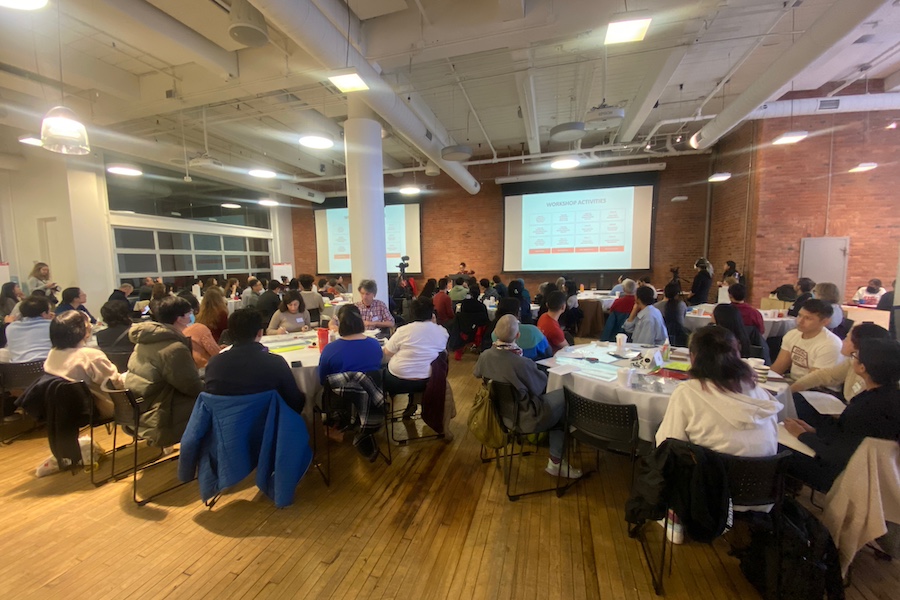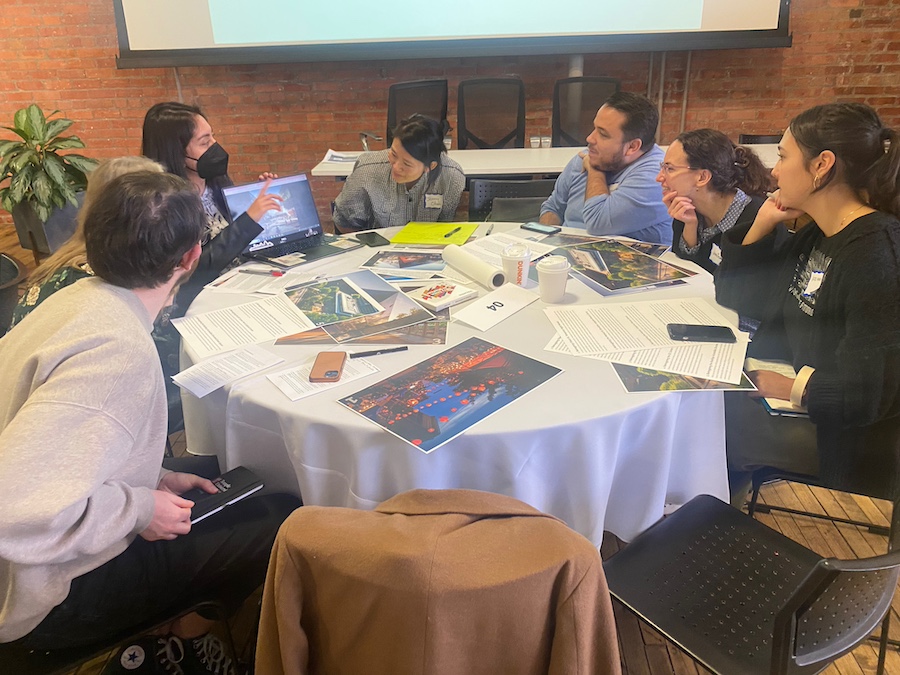Other Than a Sixers Arena, What Would You Build at Market East?
A workshop over the weekend attempted to answer that very question and produced numerous alternative ideas for Market East other than the current mall or the proposed 76 Place. But what are the odds that any of them will become reality?

Roughly 100 people attended the Save Chinatown Coalition’s planning workshop January 26th. The alternative visions for the 76 Place site they fleshed out ranged from practical to fanciful. / Photos by Sandy Smith
Should the proposed 76 Place arena move forward?
While many in the city say “yes,” many also say “no,” and several dozen of those got together with planning students and university professors this past Saturday to brainstorm projects that could take its place.
The workshop at the Center for Architecture and Design, just west of Chinatown and the proposed arena site, was organized by the Save Chinatown Coalition, an alliance of 245 community organizations that formed to fight the Sixers’ arena proposal. Arena opponents say that the facility would severely damage Chinatown and cause major disruption in Center City.
The proposals the participants produced had one overarching purpose and several major elements in common.
The overarching purpose was that the alternatives serve rather than detract from the surrounding community in general and Chinatown in particular. And every one of the participants’ ideas served that purpose.
Five broad themes emerged from the proposals:

A building-block model of the site (left) shows the site redeveloped with affordable senior housing (maroon), restaurants and other retail (blue), a school (yellow), a recreation center (white) and rooftop gardens and other green space (green). At right, a sheet explains the discussions that the AI-generated images some participants worked with were meant to spark
The site should include facilities devoted to education. Several students from the Folk Arts-Cultural Treasures Charter School advocated for a new facility for the school on the arena site. A new school closer to Chinatown’s heart, they argued, would enable it to expand beyond seventh grade and attract more students. But most of the other workshop groups also had some sort of school included in their vision.
It should have a new library for Chinatown. Right now, Chinatowners use the Independence Branch of the Free Library on 7th Street below Market. Several of the workshopped proposals called for a branch library specifically targeted to the neighborhood.
Green space is a must. Several participants spoke of producing a replacement for Center Square — the square in Thomas Holme’s original city plan that got a building placed on it. These participants noted that Chinatown lacks an easily accessible park — to reach Franklin Square requires negotiating four to six lanes’ worth of Ben Franklin Bridge-bound traffic — and a park on the Fashion District site would serve the neighborhood better. Some of the plans threaded green space through the middle of the site as a way to create a better tie between Market Street and Chinatown. And one envisioned a large domed garden sitting atop the existing building.
So is affordable housing. Most of the proposals included affordable housing as part of the package. This will happen even if the arena gets built, since 76 Place developer 76 Devcorp has added a mixed-income residential building with 20 percent of the units affordable to the arena plan.
And small local businesses should take center stage. Again, many of the proposals envisioned some sort of space for retail or seasonal markets. One participant stated flatly, “No chains!” in describing what sorts of businesses should occupy commercial space on the site.

Workshop participants discuss possible alternate uses for the 76 Place site based on photos depicting some of them
Participants worked with three different kinds of tools to get them thinking. Four groups worked with AI-generated photos of the site and its environs, using the photos as prompts to think about various uses for the site. Four others used modeling blocks and construction paper to indicate the elements they wanted to see. And the third set of four groups used clear overlays over cross-section drawings of the Fashion District building to reconstruct it to satisfy their desires.
Before the participants got down to brainstorming, they heard a presentation summarizing the results of an online survey conducted by the coalition. The survey did not ask whether respondents favored or opposed the arena but rather asked what they might like to see rise on the site.

Mary Yee of the Save Chinatown Coalition with a model of the Fashion District area
Mary Yee, who organized the survey, said the coalition did not expect to get as many responses as it did to the survey, which was open from just before Christmas through January 9th. More than 2,000 people responded to the survey, and the majority of the respondents lived outside Chinatown.
Yee explained that the results have not yet been tabulated because of the heavy volume and the need to rely on volunteers to sift through the data. But even so, she said, some things stood out even before tabulation is complete.
“What we found out was that there are so many people from all over the city who are seriously concerned about what happens with the arena, what happens to Chinatown, what happens to Wash West,” Yee says.
Yee went on to cast doubt on arena proponents’ claims that the facility would deliver significant economic benefits to Center City. She pointed to the Pennsylvania Convention Center, another project Chinatown residents opposed, as an example.
Comparing the economic studies being produced for 76 Place to those used to argue for building the convention center, she notes, “The convention center has been underperforming from the very beginning. And when it underperformed, [backers] said, ‘You need to build a hotel.’ And they built the hotel, and it was still underperforming. Then they said, ‘You need to renegotiate the labor contracts.’ And they did, but they said, ‘We’re still not getting the attendance, we’re still not getting the revenue. So let’s expand the center.’ And it’s [still] underperforming.”

One participant’s drawing emphasized the lack of recreational facilities in Chinatown by way of calling for a recreation center on the site
Put another way, the Save Chinatown Coalition argues that the arena will not only wreck Chinatown and cause traffic nightmares but also become a white elephant that proves a net drain on the public purse. In a news release issued after the workshop, the coalition charged that Councilmember Mark Squilla had reneged on his promise to withhold support for legislation needed to advance the arena proposal until a legally binding agreement with the arena developer forbidding use of public funds was signed.
At the opening session of City Council on Friday, January 25th, Squilla explained to protesters that the agreement would cover only the use of city money and that he had no control over state or federal funds.
Between the survey and the workshop, it should be clear that a non-trivial number of city residents, and not just Chinatowners, vehemently oppose the 76 Place arena proposal. And the alternatives produced at the Saturday workshop appear to deliver more in the way of direct community benefits to the Fashion District’s neighbors.
But from where I sit, it also appears that the odds of any of these alternatives becoming reality are low at best.
The reason has to do with why the 76 Place proposal emerged in the first place. The arena allows two large interests to satisfy their desires. The Sixers want to be able to rake in the revenue from the concerts, monster truck pulls, shows, ice skating performances and other ancillary events that currently go to Wells Fargo Center owner Comcast Spectacor. And Macerich, the California-based real estate investment firm that now owns the Fashion District outright after co-owner Pennsylvania Real Estate Investment Trust (PREIT) handed over its keys to the mall and $350 million in debt as part of its second bankruptcy filing in three years, would like to improve the fortunes of the floundering mall.
It’s not at all clear that, should 76 Place get derailed, Macerich would be open to a community-driven plan to either reshape or replace the Fashion District’s westernmost block. One could argue that an even better solution to the Fashion District’s woes would be simply to raze the entire mall and replace it with buildings that relate better to both Market Street and Chinatown, but the odds of that happening appear equally low.
So the fight will continue.


